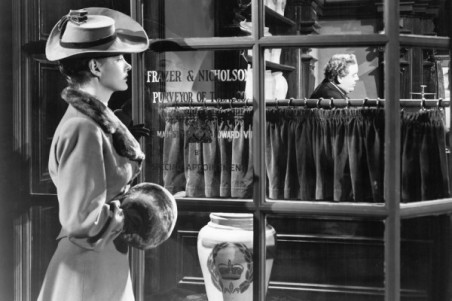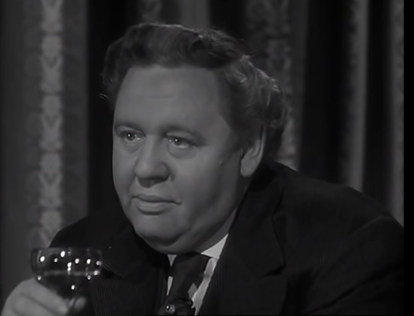
Every time I watch the 1944 film noir The Suspect (and I’ve seen it several times), I want its ending to change. As if somehow the film will, magically, halt in its tracks, mull things over, then decide to hop onto another plot path and follow it to a better (at least to my thinking) denouement. Like that bit in Gremlins 2, when we hear that Casablanca is to be shown both in color and “with a happy ending.” (Although I think Casablanca’s ending is perfect as it is; I don’t require a rewrite of that.)
But that’s the sneaky subversion of The Suspect. I always root for its kindly, mistreated murderer and hope he’ll get away with it and live happily ever after (this time, this viewing, I say, fingers crossed, it’ll be different). And I hiss at the investigating cop who wants to spoil it all. Did other audiences feel this way? And did the Motion Picture Production Code Office catch on to this? The Code explicitly forbade “sympathy of the audience [being] thrown on the side of crime, wrong-doing, evil, sin.” It’s laid out in black-and-white, with pursed lips and a frown. No doubt my knuckles would’ve been rapped with a ruler had my wishes been conveyed to the Head Office.

Yet Charles Laughton’s film character, a courtly, mild-tempered, browbeaten householder, is so, SO sympathetic and likable as the fellow who murders for a last, small chance at happiness, that I can’t help it. Yes, I think as I watch, yes, please let him get on that ship and escape! I’m almost physically urging that his getaway happens and that Stanley Ridges, as that tiresome detective, will fall off the gangplank and get snapped up by a shark. (You wouldn’t want to see a poor little shark go hungry, would you?)
True, the Code offers us sentimental viewers a loophole: “We may feel sorry for the plight of the murderer,” it allows, but “we may not feel sympathy with the wrong which he has done.” So, the Code is saying, it’s fine for us to pity, even commiserate with the purveyor of bad deeds. We’re just not permitted to feel he’s done the right, fine, and OK thing. Nor offer compassion and support. Nor give tips on the best way to off the nuisance, hide the body, and blow town. However our heartstrings may be strung by our miscreant’s predicament, by story’s end we’ve got to tut-tut, shake our heads, and bow to the inevitable.

Well, screw that, I say. It’s here the Code and I must part company. Because, within The Suspect’s context, the poignancy of Laughton’s plight is such that his actions seem understandable, even…excusable. The wife who stands in his way is a living nightmare—a thoroughly horrible, nagging, squinched-hearted scold, who threatens not only to make our poor killer’s life even more miserable than it is, but to ruin the reputation of the sweet girl he loves; while the blackmailer who torments him with exposure (look—is there anyone who likes a blackmailer?) is also an abusive, sneering lout. And Ridges makes the cop so gleefully smug and manipulative, that even the saints might sustain a quiver of empathy for poor Laughton behind the eight ball here.


Still, the film’s Scotland Yard inspector is not a bungler, nor is he evil (unlikeable, yes, but that’s beside the point…). He’s doing his job. He suspects a murder was done (and he’s right), and he needs to bring the murderer to justice. If someone is murdered, the State must administer the law. You can’t ignore that. Even if you feel sorry for the murderer, justice for the murdered, no matter how nasty a piece of work, must be done. Hence the film can be an agonizing moral bind for the viewer, torn between what feels Good and what is Right. Our only solace is that (spoiler) when Laughton’s murderer finally gives himself up, to clear (so he’s led to believe) an unjustly accused woman, it affirms our sympathy for him, our sense of a decent man driven beyond endurance, but who does what’s right. A man, in essence, noble and good, who deserves to be rooted for.
A small comfort, but the Code, at base, was a stingy thing…

Such agonies besides, The Suspect is a lovely film, a B-level gem with an A-level soul. It’s beautifully costumed and designed in the Edwardian period, beautifully photographed, written, directed (by Robert Siodmak), and acted. You can see it was not an expensive production; the Laburnum Terrace set was probably a reused New York City backlot (did Edwardian London have brownstones?). But you sense it was made with taste, care, and even love, I would say. Its whole look and tone seem perfect, even to how Laughton swings his cane or pulls his watch from his pocket. A nugget of the past seems caught in present time, preserved in permanence on celluloid.

And the film is a beautiful reproduction of the behavior and customs of a lost era, when good manners, tact, and consideration mattered. Note Laughton’s exquisite politeness to Ella Raines, the young woman he loves—how he opens the door for her and takes every thought for her comfort; or how he carries an elderly neighbor’s shopping parcels, or wraps his muffler round a small boy’s neck as a spontaneous gift. Raines’s performance is also quietly lovely and deeply sweet, and her demeanor, especially her striking eyes (light-colored and large, set in a pale face and framed by dark hair; they stand out rather eerily) fits right into this long-ago period. Raines was an underrated actress; her salute to Laughton—“My dear, my very dear,” she says as she raises a glass—is so beautifully and sincerely spoken, her eyes, face, and voice so warm and loving, it will pierce you to your core. Beyond her youth or beauty, you know, at heart, why Laughton’s character loves her.


In pre-Code time (what a wonderful time that was!), sympathetic killers did sometimes get away with literal murder: Joan Crawford in Letty Lynton and Kay Francis in Mandalay are two cases of misdoers eradicating-unpleasant-people, no consequences suffered. Had The Suspect been released some 12 years earlier, would Laughton’s unfortunate lawbreaker have also gotten away with it? Would I now be watching a film in which my hoped-for ending would be more than a mere hope?
Time is immutable, however, and cinema is a fixed artifact. And The Suspect, sad, lovely, and right film that it is, will always follow its (Code-determined) course to its pre-ordained end.
But, nevertheless, I still watch, with crossed fingers…

BONUS CLIP: Here’s a clip from The Suspect, which gives an idea of what Charles Laughton is up against. Rosalind Ivan (in a splendidly hissable performance) is his termagant wife. (Ivan seems to have specialized in such roles, playing a similarly shrewish spouse to Edward G. Robinson in another landmark noir, Scarlet Street.):
While it’s available on YouTube, here’s the complete film of The Suspect.




